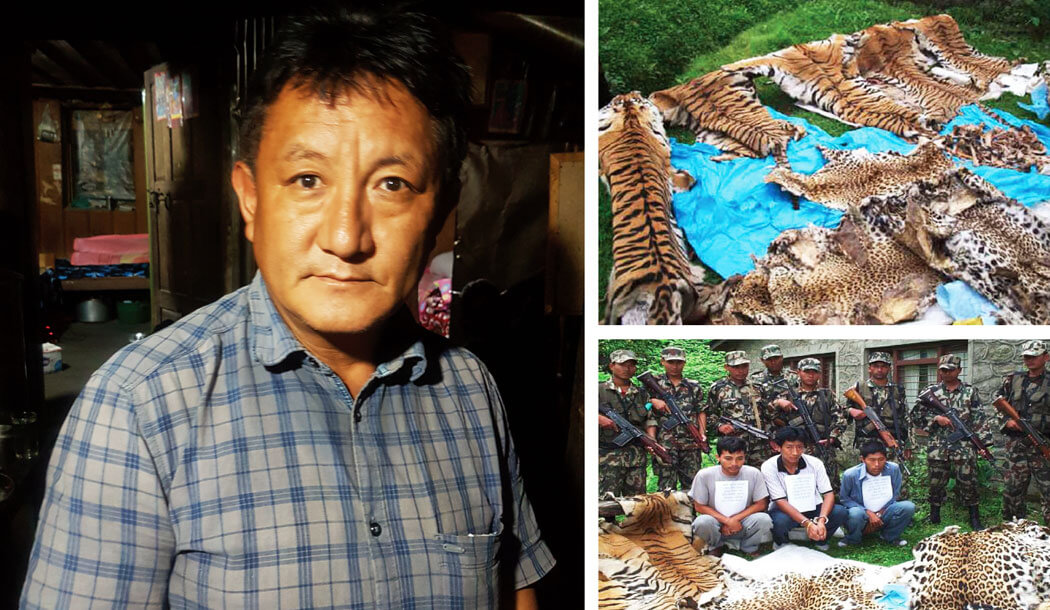Lax laws make Nepal haven for tiger poachers

Despite being the first tiger range country to claim last year that it has met the target of doubling its big cat population, a new report shows that Nepal remains an important corridor for trafficking of tiger parts from South Asia to China.
More worryingly, there is evidence that ringleaders of smuggling networks who have been caught in Nepal smuggling tiger skin, teeth and other organs to China have either used political connections to get light sentences, or have jumped nominal bail.
On 25 June, Nepal’s Central Investigation Bureau (CIB) finally arrested in Kathmandu the notorious wildlife smuggler Kunjok Lama, who had been in the crosshairs of police in India and Nepal for two decades.
His name was mentioned by traffickers arrested in every major seizure of tiger and other wildlife contraband in Nepal and India in recent years and investigation agencies in both countries as well as Interpol had been on the lookout for him.
One of the biggest hauls 15 years ago in Rasuwa yielded five tiger pelts, 36 leopard skin and 113kg of tiger bones. The Nepal Army arrested five smugglers who were trying to take the contraband to the Chinese border concealed in a cargo truck, and handed them over to the Langtang National Park.
The seizure made international headlines and was cited in The Handbook on Wildlife Enforcement in India as the most important haul of endangered species in South Asia. The accused were sentenced to seven years in jail and fined Rs100,000 each. All were released 2012 after completing their jail time. All five mentioned the name Kunjok Lama (aka Kunjok Tsering Tamang) as being the ringleader of the smuggling operation.
Kunjok Lama’s name had also popped up in successive seizures in India of wildlife contraband in Ghaziabad near New Delhi in 1999, in Uttar Pradesh state in 2000 and in Madhya Pradesh in 2008. He was named by those caught as the main ringleader in smuggling operations, and India’s Central Investigation Bureau and Wildlife Investigation Bureau had named Kunjok Lama as being behind the smuggling of at least 600 tiger pelts over the years.
He had since then been in the Interpol dragnet for the past 20 years until his arrest in Kathmandu last month.
Originally from Namkha village of Nepal's Humla district, Kunjok Lama has now challenged the Rasuwa District Court’s decision to keep him in custody at the Patan High Court, saying he has been framed and should be freed. In his appeal, Lama says he is illiterate and could not have signed the confession documents, and that he is not the person implicated by traffickers caught in Rasuwa in 2005 — even though police have mobile records from those caught which link Lama directly to the smuggling operation.
On 14 July, Judge Rajan Prasad Bhattarai of the Patan High Court wrote to the Rasuwa District Court asking for the files on the case. According to sources, the Patan High Court could call a hearing in the case within a day or two of the documents arriving, and decide whether Kunjok Lama should be kept in detention or not.
“If he is released on bail, even if the court ultimately decides he is guilty, he will disappear,” predicts a police source in the CIB’s Wildlife Pillar in Kathmandu. “And unless he is put on a travel blacklist, he will go abroad just like other smugglers we have caught before.”
Indeed, Lama has travelled extensively on ‘business’ in and out of Kathmandu even after he was implicated in the 2005 raid, and immigration records show he has been to the United States twice since then.

A 2018 census in Nepal showed that the country had 235 wild tigers in national parks, which is double the population in 2009. This made Nepal the first country among tiger range countries that had given themselves the target of doubling the number of tigers by 2022.
Nepal has one of the strictest laws on smuggling of endangered animals like tigers, rhinos, leopards, pangolins, or wild elephants among South Asian countries, with up to 15 years jail terms and/or up to Rs1 million fines for those found guilty. However, court records show that no one has ever received this maximum sentence even after being caught for major smuggling operations like the one in 2005. The perpetrators have either used legal loopholes to be released, or have received the minimum sentences.
Conservationists say political patronage, corruption in the judiciary and poor prosecution are the reasons why the provisions for hefty penalties for wildlife smugglers have never been implemented, and why many end up free to resume their smuggling activities.

Another high profile smuggler who has escaped prosecution is Lodu Dime (pronoucned ‘dee-may’), who was arrested in 2012 after a cargo truck driving from Kathmandu to the Chinese border in Rasuwa was apprehended. Hidden behind sacks of rice were five tiger pelts and six large sacks with 512 pieces of tiger bones, skulls and claws and 122 fangs. Conservationists calculated that the contraband must have come from at least 31 dead tigers.
The driver and truck owners were arrested, and they named Lodu Dime of Boudha in Kathmandu as the person who hired their truck for Rs100,000 to take the rice to Rasuwa. Police raided Dime’s house and confiscated a large haul of wildlife contraband, eight passports and Rs4 million, as well as Indian, Chinese, Bangladeshi and Indonesian currency.

Lodu Dime fled, but returned to get himself cleared by the courts after paying a nominal Rs100,000 fine, and his wife who had been arrested was also freed. However, the Appeals Court sentenced him in absentia to five years in prison. Despite this, records show that Dime kept travelling freely back and forth between India and Nepal.
With help from Interpol, Dime was finally caught in New Delhi in 2017 after the Indian CIB found he was involved in poaching tigers in Madhya Pradesh. He was extradited to Nepal in 2018 and sent to the District Jail in Nuwakot to serve his five year sentence. But Dime appealed at the Supreme Court where the bench of Justices Mira Khadka and Dambar Bahadur Shahi decided to release him on only Rs45,000 bail. Dime then disappeared.
“The bail amount was negligible compared to the cash value of the contraband, the court never put a travel ban on him, and after jumping bail he was back to his smuggling activities,” a Nepali CIB official involved in the investigation told Nepali Times.

Police have now uncovered links between Lodu Dime and Kunjok Lama, and found that they sometimes worked together to make Nepal a collection point for wildlife smuggled from India, Bangladesh and Sri Lanka to be transported to China through Kodari, and later Rasuwa checkpoints.
In the past five years alone Nepal’s CIB has caught red handed 73 tiger smugglers in 31 raids. Among them are nine Indians and two Chinese. Just in the past five years, the seizures have included 28 tiger pelts and 139kg of tiger bones. Although many of the tigers were probably poached in India, two tigers were found to have been killed in Nepal, one was poisoned and other electrocuted.
The nine Indians arrested in Nepal are from the Babriya forest-dwelling community in India who have skills in wildlife tracking. One of them was Ramjas Banjara, who served as the link between poachers in India and smugglers in Nepal who trafficked the wildlife parts to China.

Banjara was caught in Bardia with one tiger pelt and 15kg of tiger bones, and was handed the minimum sentence by law of five years in jail by Nepalganj Court, and was released in April after serving his term.
“Notorious smugglers get only the minimum five years in jail, and a whole lot of Indian smugglers in Nepal’s jails who are part of the smuggling network are now in line to be released,” says Police Sub-Inspector Birendra Johari, who have been involved in numerous sting operations against wildlife smugglers.
Of the six other Indian smugglers caught in a CIB sting operation in Kailali in 2015 that seized two tiger pelts and 40kg of bones, five were released on bail after paying Rs100,000 each and immediately escaped to India. This was the first time that so many Indian smugglers had been caught in one operation in Nepal, confirming the involvement of Indian poachers in Nepal.

The Babriya also knew how to kill tigers without a gun which ends up damaging the pelt with bullet holes, and reduces its sale value. Since every part of a tiger can be sold in China and Vietnam, there is hardly any evidence if a tiger has been poached. Wildlife smuggling has increased during the COVID-19 lockdown.
A report by the UN’s World Wildlife Crime Report 2020 says that there has been a marked increase in the poaching of tigers between 2007 and 2018, mainly in India and Thailand. But it notes that smuggling is also rife in Nepal, Bangladesh and Bhutan.
‘All parts of the tiger are traded and used for traditional (Chinese) medicine, but the bones are generally most sought after,’ the report says. ‘Consumer demand has shifted in recent years with tiger product buyers purchasing these goods as a sign of wealth rather than for their health. The most popular bone-based products appear to be tiger wine and tiger glue/paste. The trade has shifted to online sales through social media and messaging apps.’

The trafficking in protected species report by the Vienna-based UN Office of Drugs and Crime investigated 600 incidents of tiger smuggling and found that parts of South Asia have become hotpots of tiger poaching and smuggling — especially using Nepal as a transit point to China. The Handbook On Wildlife Enforcement in India also cites Nepal as a main corridor to China for smuggling of tigers killed by poachers in India. (See map)
The report also notes that besides the threat to biodiversity and national security from criminalisation, there are also serious health implications of illicit wildlife trade: ‘The illegal trade in wildlife, which by definition does not go through proper sanitary and phytosanitary controls, can potentially lead to the spread of zoonoses, such as SARS-CoV-2 that caused the COVID-19 pandemic.’
The reputation of the court system in Nepal which was already under scrutiny for corruption, has been tarnished even more this month by the Supreme Court Chief Justice and another judge freeing a senior police officer sentenced to life imprisonment for brutally murdering his wife and burning her remains.
There has also been intense media spotlight on another bench of the Supreme Court which this month released on bail a member of a prestigious family who had killed a woman while driving under the influence of alcohol last year.
Trafficking in protected species 2020
UNODC, World Wildlife Crime Report 2020,
United Nations Office on Drugs and Crime, Vienna
134 pages





